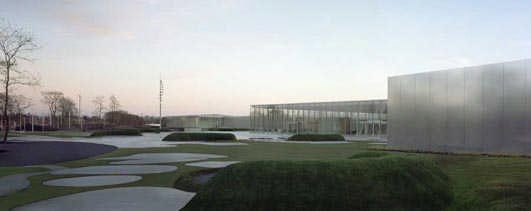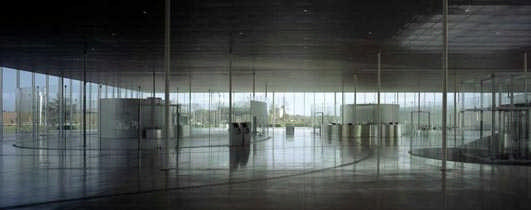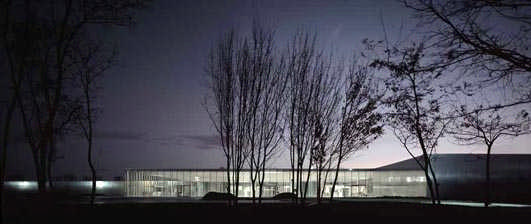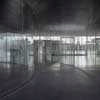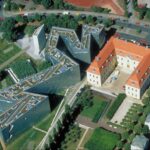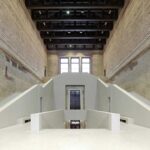Louvre Lens Museum, French Building, Project, News, Design, Opening
Musée Louvre Lens, France : Cultural Development
Musée Louvre-LENS – design by Sanaa / Imrey Culbert / Catherine Mosbach
12 + 11 Dec 2012
Louvre Lens Museum Building Photos
Photographs of Musée Louvre First Satellite, Co-Designed by SANAA and Imrey Culbert, Opens in Lens, France
Co – auteurs du Musée du Louvre-Lens : (c) SANAA / Kazuyo Sejima et Ryue Nishizawa – IMREY CULBERT / Celia Imrey et Tim Culbert – MOSBACH PAYSAGISTE / Catherine Mosbach:

photograph © Hisao Suzuki
New photos of this major building – elegant architecture but maybe a little too severe, utilising the simple interior volumes that SANAA are well known for and their beautiful use of well-detailed curved glass, but unlike their recent Swiss project which undulated like a landscape this project is flat and some of the facades appear overly austere and lacking in charisma.
The Louvre Lens Museum gives us refined but rather austere architecture – redolent of the simple volumes of Mies van der Rohe (eg National Gallery Berlin or Crown Hall) but in a very light style, finely detailed. But when compared with say the Pompidou’s sojourn into the countryside (the rather bizarre Centre Pompidou-Metz by Shigeru Ban) this building, especially the opaque facades, has moments of dullness. A little more Joie de vivre would have been welcome!
Co – auteurs du Musée du Louvre-Lens : (c) SANAA / Kazuyo Sejima et Ryue Nishizawa – IMREY CULBERT / Celia Imrey et Tim Culbert – MOSBACH PAYSAGISTE / Catherine Mosbach:


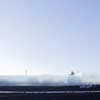

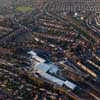
photograph © Iwan Baan
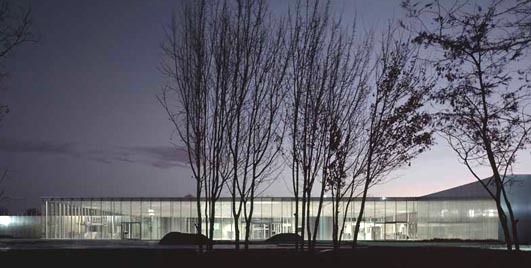
Design © SANNA / IMREY CULBERT / MOSBACH

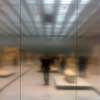
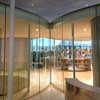
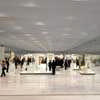
Design © SANNA / IMREY CULBERT / MOSBACH

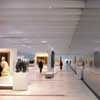
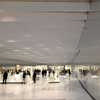
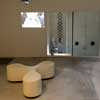
Design © SANNA / IMREY CULBERT / MOSBACH
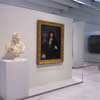

Design © SANNA / IMREY CULBERT / MOSBACH
4 Dec 2012
Louvre Lens Museum Building
Musée Louvre First Satellite, Co-Designed by SANAA and Imrey Culbert, Opens in Lens, France
Musée Louvre First Satellite Opens in Lens, France
Winning Design by Sanaa, Imrey Culbert and Mosbach Complete After 7 Years of Design and Construction
NEW YORK – The Louvre Museum’s first satellite opens on December 4, 2012 in Lens, France. Co-designed by Tokyo-based Sanaa and New York-based Imrey Culbert, with the landscape design by Paris-based Mosbach Paysagistes, Louvre-Lens comprises 300,000 square feet of new construction, devoting over 75,000 square feet of galleries and visitable storage areas for hundreds of treasures from the Louvre’s collection.
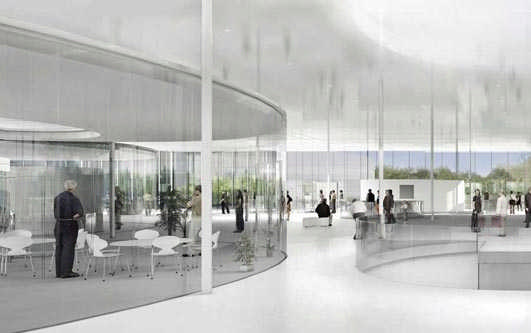
Louvre Lens Museum image © Sanaa / Imrey Culbert / Catherine Mosbach
The museum consists of five pavilions–low one-story structures, connected at their corners, that grace, enhance and dissolve into the landscape rather than overpower it. Aside from the entrance glass pavilion, the buildings are clad in a reflective aluminum, creating blurred reflections of the surroundings, changing with the scenery, the weather and the position of the person viewing it.
“Our design, reminiscent of the Louvre in Paris with its outstretched wings, was conceived to integrate the building into the park on a single accessible story,” – said Celia Imrey, co-designer with Tim Culbert and principal of Imrey Culbert, New York, “Now that the project is complete, the ‘museum-park’ concept is finally a reality.”
Imrey, who recently started her own firm, Imrey Studio, is particularly excited about how the museum and the regional government plan to integrate the local history and culture. The local population of Lens, who has suffered for years from war and the grim mining industry, was invited to participate in the opening festivities.
The museum’s largest space, the opaque Galerie du Temps (Gallery of Time) hosts a semi-permanent exhibition of art works from prehistoric to the 19th century. Shown in chronological order, the exhibition allows for comparisons to be made across cultures–a striking departure from the way art is exhibited in the Paris Louvre.
“Inside the museum, we designed the main gallery wings to have natural daylight only from above. There are no windows,” says Imrey, “Between Sanaa in Japan, Imrey Culbert in New York and Paris, ARUP in London, and structural engineers Bollinger and Grohman in Frankfurt, the roof alone is a truly international accomplishment.”
The center glass pavilion, a variation on the pyramid of the Paris Louvre, serves as the main reception area and a public space for the local population and houses a multimedia library, museum store and cafeteria. An Introductory Gallery, accessible via a large staircase, is a place where visitors can peer down onto the museum’s reserves and the studios where artworks are prepared for display.
The main storage area is available for public visits by small groups of 15 people per tour. The next pavilion houses temporary exhibitions, and the final houses a 300-seat auditorium.
Basic Facts:
• Location: Lens, France
• Client: Region Nord – Pas-de-Calais, 1 : 15 min Northwest from Paris by train
• Construction budget: €150 million
• Size: 300,000 square feet for building, 75,000 square feet of galleries
• Anticipated Attendance: 450,000-550,000 visitors/year (700,000 anticipated the first year)
• Louvre collection – Antiquity to 1850, primarily European and Near East / North Africa
• On display: Works from the galleries of the Louvre, Paris (including Raphael, Fragonard, Veronese, Rembrandt and Botticelli).
• 300-seat Auditorium
The Design Team:
• SANAA – Tokyo / Architect, Leaders of the Team, Co-Designers Kazuyo Sejima + Ryue Nishizawa
• IMREY CULBERT LP – New York / Co-Designers, Museography / Gallery Design Celia Imrey + Tim Culbert
• MOSBACH PAYSAGISTES – Paris/ Landscape Design, Co-Designers
Architectural and Engineering Joint Venture Team:
Bureau Michel FORGUE – Paris / Pricing and quantity surveyor; BETOM Engénierie – Versailles / MET and structural engineers; TRANSPLAN- Stuttgart / Energy and comfort concept; Hubert PENICAUD – Paris / Environmental design engineers; Sasaki Associates – SAPS- Tokyo / consultant structure concept; BOLLINGER + GROHMANN GmbH- Frankfurt/ Structural engineering and facade engineering; ARUP LIGHTING – London / Artificial and natural daylighting; AVEL ACOUSTIQUE – Paris/ Acoustical engineers; GROUPE CASSO – Paris / Code and fire security.
Other team members:
EXTRA MUROS – Paris, Antoine Belin – Paris / Operating architects; Studio Adriene Gardere- Paris/ Scenography / Museography.
About Imrey Studio www.imreystudio.com:
Imrey Studio specializes in architectural design and consultation for cultural institutions.
Our goal is to provide design solutions that highlight institutional mission and goals while articulating public experience and use of individual spaces. We focus on elegance, economy, and clarity.
Imrey Studio, a registered Woman-Owned Business, is founded by Celia Imrey, also a founding partner of Imrey Culbert Architectes sarl and Imrey Culbert LP.
15 Nov 2012
Louvre Lens Museum Opening
MUSÉE LOUVRE-LENS GRAND OPENING
Public Opening: December 12, 2012
Louvre Lens Museum
Lead Design Architect Tim Culbert, formerly of Imrey Culbert and now founder and principal of Atelier CULBERT is pleased to announce the inauguration of the new satellite museum for the Louvre, located in the northern former mining city of Lens, France. In a joint venture with SANAA of Tokyo, Architect Tim Culbert is the co-author of the building architecture and museography with Kazuyo Sejima – having invited his Japanese counterpart to join a team he created in 2005.
Architect Tim CULBERT, co-author Louvre-Lens
The joint-venture team included Mosbach Landscape Design of Paris, and engineers Arup of London and Bollinger + Gohmann of Frankfurt for the international competition that included 116 firms worldwide.
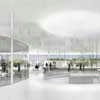
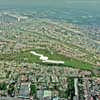
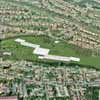
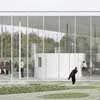
Louvre Lens Museum images © Sanaa / Imrey Culbert / Catherine Mosbach
The Louvre-Lens project represents a significant cultural and political success for the Region of the Nord pas-de-Calais, close to the Belgium border, which spent 10 years prior to the museum launch bidding against other northern French cities as a unique “decentralized” location of France’s art heritage. Since the construction launch of the satellite museum, the Louvre Museum has proceeded with its expansion plans, notably with the recent opening of the Cours d’Islam in Paris and the Louvre Abu Dhabi by Ateliers Jean Nouvel, currently under construction.
Tim Culbert, an American architect raised in Japan and Switzerland with a degree in architecture from France, considered the Louvre-Lens competition to be a perfect platform to merge both his personal background, with his knowledge of both French and Japanese cultures to address the paradigm shift of the museum in today’s society. Creating a Japanese-American team for the Louvre competition was an overt attempt to address all of these in one building type and the nucleus of its collection – perhaps equally known in printed and digital format than in real life, despite the greatest visitorship per year of any museum in the world – with an approach that would put on equal footing siting and landscaping, art and conservation, visitor flow and architectural forms.
The built project, the currently in-progress landscaping work (2012-2013) and installed exhibits fuses artifacts, painting and sculpture with architecture, circulation and nature, engaging the visitor in a new social space and expanding the imagery and visitor’s confrontation with the Louvre’s archive of artistic practice. The transversality that is achieved, integrates and regenerates classic art forms and techniques, embracing an overt approach to a “panoramic culture”, bridging classic art departments or formats, appropriate to a new generation of viewers, as well as an experienced viewership seeking alternatives to how cultural history is represented. The building is a receptacle, ethereal – at times invisible – backdrop to this agenda, allowing for a broad range of experiments on how meaning is made through perception. To paraphrase the artist Anselm Kiefer, the new Louvre-Lens takes a risk – ‘expanding and building an arch across time; stretching the curving rainbow of art across historical intervals’1.
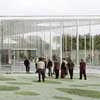

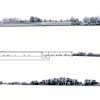
Louvre Lens Museum images © Sanaa / Imrey Culbert / Catherine Mosbach
The original design text and presentation in 2005 included the following text (and oral presentation to the Senate by Tim Culbert), remains relevant to describe the built work 7 years later: “The design for the new satellite of the Louvre consists of gently curving pavilions that dovetail with the landscape – a 62-hectare former mining site – creating a “museum-park”. The roofs of the galleries are entirely glazed and slightly diffused, ideal natural daylighting under the grey skies of Lens. The ethereal quality of the façade – a single height of brushed aluminum alternating with clear glass – and the slight curvature of the pavilions will create blurred reflections of the surrounding landscape. This out-offocus impression speaks to the new mission of Louvre-Lens: to question reality and perception, to teach how to look at art anew. Gallery volumes are gently linked at their corners, allowing for a transversal experience of the rotating exhibits. The design reinforces the curatorial blueprint, effectively repealing the classic art departments that have defined – and confined – the collection in the Louvre Palace over the last two centuries.” TC
Designed as a series of wings that spread-out from a 4,000 square meter central hall, the project acknowledges and undoes the hierarchical typology of the Paris museum itself, with difficult to reach multi-floor “wings” around the people-mover hall designed by I.M. Pei. At the Louvre-Lens, the gallery wings and public spaces are all on one level and spread out asymmetrically from the entirely glazed entrance hall, creating a tension in its relationship with the landscape, while not entirely dismantling the concept of centrality and cartesian symbolism of the “original” Louvre.
The satellite museum will include a visitor-guided storage and conservation area, located at the core of the cluster of buildings – directly below and accessible from the main hall building itself – to speak to its dual mission for the preservation and display of artifacts and artworks.
The 30,000 square meter, 150 million Euro stand-alone building is the first museum designed and built in France by SANAA and Imrey Culbert. Culbert was a founding principal of Imrey Culbert until the firm dissolved in 2011 and is now principal of Atelier CULBERT based in New York and Paris.
Architect Tim Culbert, is the co-author for the overall building design and museographer for the project. The international competition was won by SANAA and Imrey Culbert Architects with Mosbach (Landscape Design) and a large international design and engineering team.
Client: the Region Nord Pas-de-Calais in partnership with the Louvre Museum in Paris.
Complete team credits can be found at www.louvrlens.fr
About Tim Culbert’s Firm
Atelier CULBERT is an internationally recognized architecture practice based in New York and Paris, with a focus on museum and gallery design. Founded by Tim Culbert, formerly design partner with Imrey Culbert, the practice specializes in delivering museum projects, expansions and exhibit designs for clients who want innovative and cost-effective building solutions. We also have expertise in strategic planning and feasibility studies to transform historic sites and buildings for cultural uses worldwide.
The atelier works both independently and in joint ventures with other architectural and engineering practices to best respond to a given project’s context and resources. This collaborative and multidisciplinary approach, combined with our experience, intuition, and graphical capability, has led to numerous collaborations with some of the world’s leading architectural practices, from Jean Nouvel to Renzo Piano, and I.M. Pei to SANAA.
Museum design
In museum architecture, sequence and interaction play an implicit but often overlooked role in defining the visitor’s relationship to the built environment. Accordingly, all of our projects are designed with sensitivity to the performative nature of the visitor’s experience. This requires forms of museography, technology and design sufficiently flexible to foster unique encounters within a curated space.
Collaborative Practice
We believe that strong partnerships and client collaborations create design solutions that are simultaneously beautiful and highly functional. Our analytical and graphical approach to design development and our experience working on buildings on three continents enables us to smoothly integrate complex teams and to communicate vividly with our clients and partners – a performative approach to design collaboration.
About Tim Culbert
Tim Culbert was raised in Japan and Switzerland, studied at Carnegie Mellon University, eventually moving to France where he received his Master’s of Architecture from the École Spéciale d’Architecture in 1984.
In New York, Culbert worked with I.M. Pei for over a decade and oversaw the design and construction of the Miho Museum in Shiga, Japan, which opened in 1997. He was also the architect-in-charge of Pei’s Museum of Modern Art in Luxembourg. He began his private practice in 2001 as founding partner of Imrey Culbert where he lead the design for the Rubin Museum of Art in New York and the Smithsonian’s American Art Museum’s Contemporary and Modern Art Galleries in Washington, D.C. In 2005 Culbert won the international competition for the new satellite of the Louvre Museum, in Lens, France, in a joint venture with SANAA of Tokyo. As co-author of the 30,000 square meter new museum, Culbert established a sister office in Paris, to oversee the design and construction phases. The project will open to the public in December 2012.
In June 2011, Culbert announced the opening of his new practice Atelier Culbert based in New York and Paris.
On-going projects include the Queen Sirikit Museum of Textiles in the Grand Palace in Bangkok and an expansion to the Musée Dobrée, an archeological museum in Nantes, France and an invited design-build competition for the new Algerian Parliament on the bay of Algiers, in collaboration with Pei Partnership Architects.
Web Blogs:
http://www.imreyculbert.blogspot.com
Portfolios:
Portfolio links:http://www.studionu.nu/culbert/Portfolio_Daly_Vol1.pdf http://www.studionu.nu/culbert/Portfolio_Daly_Vol2.pdf
21 Jan 2010
Louvre Lens Museum
IMREY CULBERT’s highly anticipated design with SANAA and Mosbach Paysagistes for the new branch of the Louvre in Lens, France.
The Louvre Lens Museum will be realized by 2012. Imrey Culbert is the co-designer for the building and the “museography” (exhibition design).
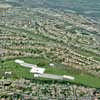
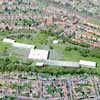
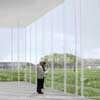
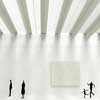
Louvre Lens Museum images © Sanaa / Imrey Culbert / Catherine Mosbach
Musée Louvre-LENS Breaks Ground
Winning Design by Imrey Culbert and Sanaa Will Be Realized By 2012
NEW YORK – The highly anticipated ground breaking for the Louvre LENS recently took place on December 4, 2009 atop a former mining site near the city of Lille in Northern France. Co-designed by New York-based Imrey Culbert, Tokyo-based Sanaa, and Paris-based Mosbach Paysagistes, the new branch of the Louvre will span 300,000 square feet of new construction, devoting over 75,000 square feet of galleries and visitable storage areas for hundreds of treasures from the Louvre’s collection.
“To be a part of the laying of the first stone ceremony, with my co-designers, France’s Culture Minister Frederic Mitterand, officials from the Louvre and former mine workers,” says Celia Imrey, a principal of Imrey Culbert, “Gave me a sense of how important this new museum is, not only as a cultural destination, but also as a key factor in the renaissance of a town that has seen much suffering from mining and war.”
The 153 acre site selected for the Louvre-LENS is slightly higher than its surrounding. As a result, the design strategy calls for a series of five pavilions – low one-story structures that will grace, enhance, and dissolve into the landscape rather than overpower it. All of the buildings, whether reflective or transparent, meander slightly along with the gentle curves of the site. To actually fuse nature with the structures, highly reflective polished and anodized aluminum façade clad the volumes, creating blurred reflections of the surroundings, changing with the scenery, the weather, and the position of the person viewing it.
“The design is said to be reminiscent of the Louvre in Paris with its two outstretched wings,” says Imrey.” We conceived this new Louvre to be everything the Palais Louvre is not, and sought to create transparency both literally and figuratively.”
The two easternmost pavilions are the principal exhibition halls, one being the opaque Galerie du Temps (Gallery of Time) – a semi-permanent exhibition of artworks regardless of styles and places of origin and arranged in chronological order, which is a striking departure from the way art is exhibited in the Paris Louvre. The center pavilion, a square glass volume will serve as the main reception area and a public space for the local population and will house a multimedia library, museum store and cafeteria. An Introductory Gallery, accessible via a large staircase, is a place where visitors can peer down onto the museum’s reserves and the studios where artworks are prepared for display. The main storage area will be visitable by small groups of 15 people per tour. The next pavilion will house temporary exhibitions, and the final will house a 300-seat auditorium.
Since it was founded in 1793, the Louvre has been a national museum whose collections and skills are available to the entire nation and whose mission is to reach out to regions beyond Paris. The Louvre Lens will have its own departments and a full range of artistic, social, and educational programs and activities. Though it won’t have a collection of its own, it will be filled with works of art from the collections of the Louvre that will be on temporary exhibition. The works will be presented in new and innovative ways, giving them new meaning and making them more culturally accessible. One of the museum’s objectives will be teaching the public how to look at art. Works will be presented in an educational context, which will draw heavily on the latest information and communication technologies. To make the works easier to understand, the collections will be displayed transversally, reaching beyond the limits of the traditional museum departments, thus giving visitors a new understanding of the works.
“Our firm,” says Celia Imrey, a principal of Imrey Culbert, “has had much experience in museum and exhibition design; to be a part of the laying of the first stone ceremony was momentous. Once realized, our design will make it possible for the masterpieces of the Louvre to be on view in new and innovative ways, giving them new meaning and making them more culturally accessible.”
The design team consists of internationally acclaimed designers and engineers:
Architectural Design Team:
– SANAA -Tokyo / Architect, Leaders of the Team, Co-Designers Kazuyo Sejima + Ryue Nishizawa /
– IMREY CULBERT LP – New York/Co-Designers, Museography/Gallery Design
Tim Culbert + Celia Imrey
– MOSBACH PAYSAGISTES – Paris / Landscape design, Co-Designers
Architectural and Engineering Joint Venture Team:
– Bureau Michel FORGUE – Paris / Pricing and quantity surveyor
– BETOM Ingénierie – Versailles / MEP and structural engineers
– TRANSPLAN – Stuttgart / Energy and comfort concept
– Hubert PENICAUD – Paris / Environmental design engineers
– Sasaki and Pertners – SAPS – Tokyo / Consultant structure concept
– BOLLINGER + GROHMANN GmbH – Frankfurt / Structural engineering and façade engineering
– ARUP LIGHTING – London / Artificial and natural daylighting
– AVEL ACOUSTIQUE – Paris / Acoustical engineers
– GROUPE CASSO – Paris / Code and fire security
Other Team Members:
– EXTRA MUROS – Paris, Antoine Belin – Lens / Operating architects
– Studio Adriene Gardere – Paris / Scenography/ Museography
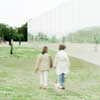


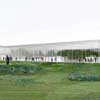
Louvre Lens Museum images © Sanaa / Imrey Culbert / Catherine Mosbach
Basic Facts:
– Location: Lens, France
– Client: Region Nord – Pas-de-Calais, 1:15min Northwest from Paris by train.
– Construction Budget: 150 million euros.
– Anticipated Attendance: 450,000 – 550,000 visitors/year (700,000 anticipated the first year)
– Louvre collection = Antiquity to 1850, primarily European and Near East/North Africa
– On display: works by La Tour, Raphael, Fragonard, Veronese, Rembrandt, and Botticelli are among those selected for display.
Louvre Lens Museum images / information from Imrey Culbert
Location:Lens, France
New Buildings in France
French Architectural Projects
French Architect Offices – design firm listings
Paris Architecture Tours by e-architect
French Architecture – Selection
Zaha Hadid
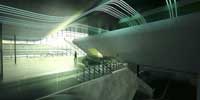
picture from architects
The Phare
Morphosis

image from architect
Zenith Music Hall Strasbourg
Massimiliano Fuksas Architecture
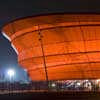
photo : Moreno Maggi
Comments / photos for the Louvre Lens Museum French Architecture page welcome
Louvre Lens Museum Building


